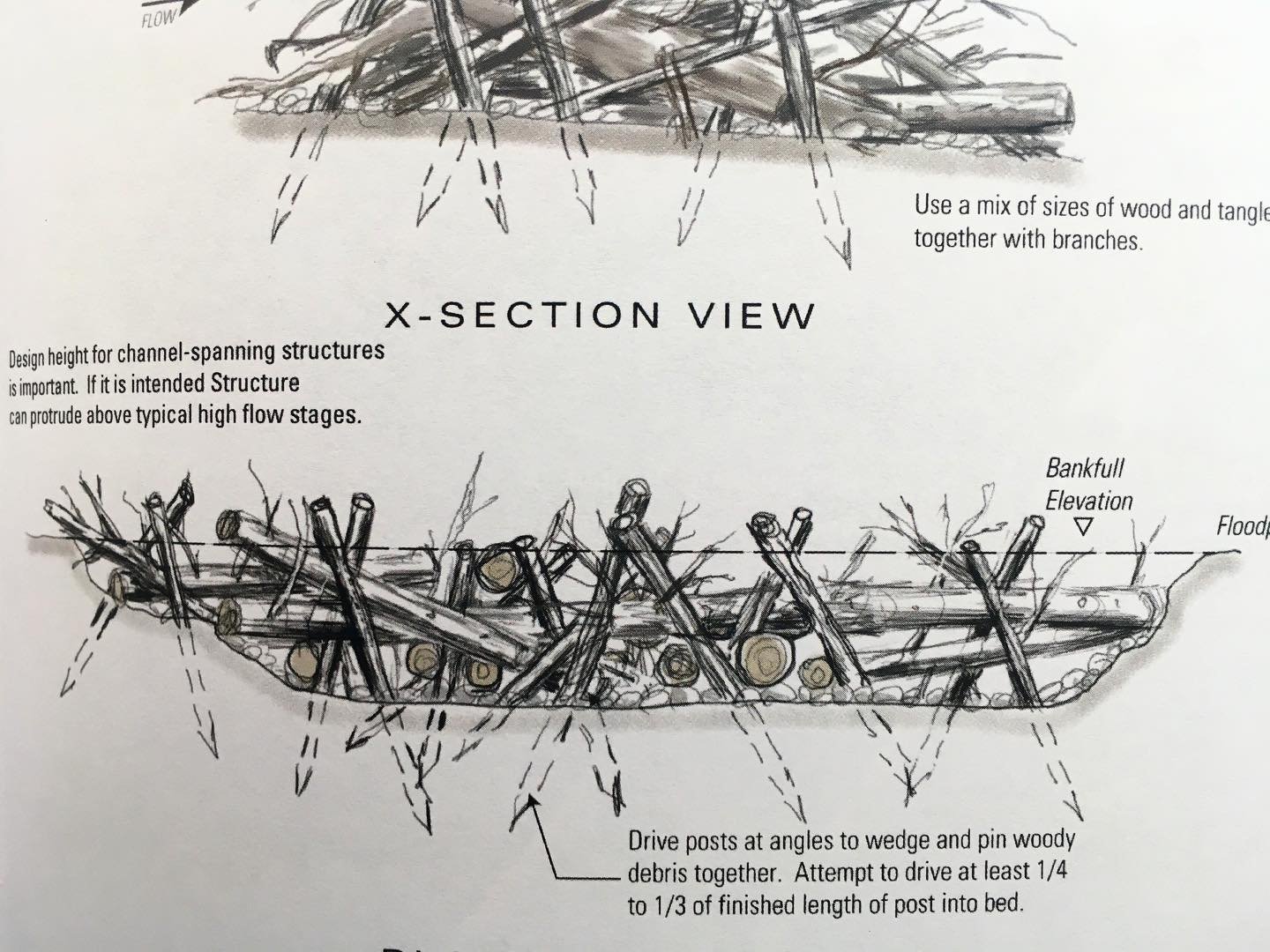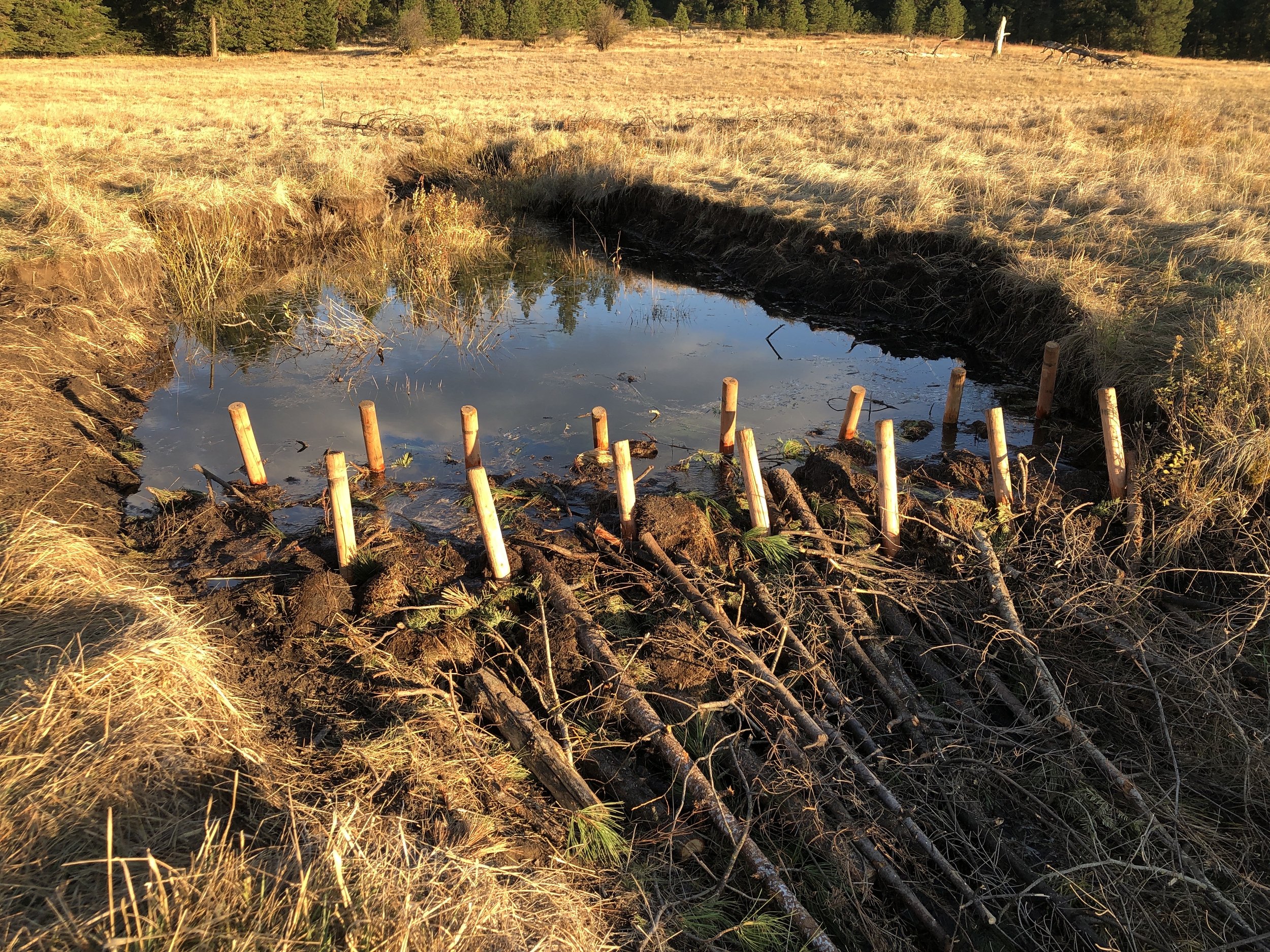Behind the Beaver Days: the story of long-awaited restoration
We can’t wait to show and tell you all about the work we have done over the last few years at the Vesper Meadow Restoration Preserve, but to fully understand the context, the story really must be told by first going back, way back to a time immemorial.
The surviving native Camas lily gardens at Vesper Meadow are legacy of Takilma, Latgawa, Shasta, Klamath peoples and others having tended the wet meadow ecosystem in our region for at least 10,000 years. (pc Mark Lunn Photography)
“For thousands of years our ancestral Tribal peoples of Western Oregon have lived not just on the land, but with the land, coaxing it into peak production for diverse resources, habitat types and the species that thrive in those diverse environs…. These interactions with our landscapes did not happen by chance. They were taught through generations of practice and observation: which fire or other treatments were beneficial, what times and conditions produced safe renewal and abundance. Always there were specific targeted goals: to enhance traditional food plants, to maintain hunting grounds, to tend basket materials, etc.”
- Robert Kentta 2022, Confederated Tribes of Siletz Indians
Part of our journey to prepare for creek (and meadow) restoration was to find out everything we could in historical records. The earliest anecdote that we were able to find was a quote from Molly Orton, a Latgawa elder who was one of the few people that gave detailed information to a white ethnographer about the southwest Oregon region. In John Harrington’s notes, Orton is quoted for saying that “near the headwaters of Dead Indian Creek, there is a favorite Camas-digging meadow called Ti’nth.” And so FYI, Dead Indian Creek was recently renamed Latgawa Creek…this is the creek running through Vesper Meadow!
If you live in the Western US, you must know Camas… it is iconic in spring with purple blooms across Vesper Meadow and meadows throughout the west. It has been so important as a First Food, we could liken to the current staple of potatoes in today’s dominant culture in America. (Read more on Camas)
For the sake of this post, it is important to know that
Camas loves wet meadows and is an indicator of a healthy wet meadow.
Indigenous peoples actively tended Camas meadows as native gardens to increase this food supply and other food plants
Historic genocide and forced removal of Native people from these lands equates as a loss of the original land stewards from the ecosystem and is a significant factor in the degradation of the landscape.
General Land Office survey maps provide insight in to the interconnected network of wet meadows that once were in the current Vesper Meadow region.
Today, Siletz Tribal member Robert Kentta makes a case for Tribal-led and collaborative action,
“The dire emergencies that we and our landscapes face in this century cry out for considered, collaborative, devoted action, and for lessons born of long experience. We have ancestral knowledge (both passed down through the generations to today, and from interviews with elders of generations past). We have modern sciences to assist us. We have historic resources, such as careful work of the early General Land Office (GLO) surveyors, which sometimes give us startling glimpses of the texture of our landscapes from before fire suppression became the new, and ultimately disastrous, law of the land.”
With respect for the original land stewards, as with an understanding of our current ecological crisis being a result of ongoing settler-colonialism, we are honored to work with the Tribes of record (Confederated Tribes of Siletz Indians and Confederated Tribes of Grand Ronde) and support their goals for restoration on the landscape. We are humbled to learn from their long standing body of knowledge about the place, and inspired to serve in their efforts through the Indigenous Gardens Network. We will continue building relationships and work to support their long term goals for land management and reacquisition in southwest Oregon. In the meantime we carry on this work in dedication to the native ancestors who have come before and to their living relatives.
Monitoring and measuring Latgawa Creek
We believe that with a fuller understanding of the ecosystem, with a relationship to the place, we can do right by all the living creatures here. Further, we hope that by looking at the whole meadow community, we will be able to help inform other restoration work around the region.
Right off in 2018 we started developing lists of plants, butterflies, dragonflies, collaborated with the Klamath Bird Observatory for a baseline bird community survey, established riparian photopoints, found a volunteer to gather drone imagery, worked with college student interns to count creatures in the creek and assess the beaver habitat potential, and started the search for funding to further our data collection.
Ongoing creek flow measurements by Vanessa Robertson-Rojas with the support of Oregon Water Enhancement Board
Geologic assessment with local geologist Jad D’Allura 2019
Rearing to go
As we started to research, observe, monitor the creek and all the inhabitants of the water and meadow, we realized that any significant action was going to require us to raise significant funds, undergo partnership building and a permit process, and might take a few years. SO in the immediate term, we engaged volunteers where we could. We were fortunate to work with the local Rogue River Watershed Council to initiate strategic willow planting that jumpstarted some healing in the creek.
Strategic willow stake planting in the form of “live gully breaks” or “living weirs” to help arrest the ongoing entrenchement of the creek, especially during spring runoff when sediment erosion is high.
Then and Now…
(and we might just plant willow for the next 50 years!)
2018
The very first work party for willow stake planting just a couple months after the establishment of the Vesper Meadow Restoration Preserve 2018
2022
2019
By early summer 2019, willow plantings have started to establish and slow the creek flows, enabling other riparian vegetation to take root.
By mid-summer 2022, annual willow plantings by volunteer work parties, students, and the Vesper Meadow stewards have taken hold and continue to capture eroding sediments.
People-powered restoration 2018 - 2022: willow staking, riparian plantings, invasive weed removal
Volunteers planting willow stakes 2020
Developing the support network
During a butterfly monitoring training event with the Xerces Society at Vesper Meadow, we met Sheri Hagwood, biologist with the US Fish and Wildlife Service out of Yreka, Ca. She offered to collaborate via the USFWS Partners Program that supports wildlife habitat conservation work on private properties. Sheri has been invaluable for supporting this work, not only through funding work and materials but also supporting the permitting process (more on that epic journey later).
The Beaver Coalition has collaborated for restoration planning and project implementation.
Jackson County Soil and Water Conservation district is supporting enhanced wildlife and First Food habitat restoration work in conjunction to the in-stream restoration work.
Through the BLM Resource Advisory Committee’s Title II program, we are able to build off of the creek restoration work to restore the meadow floodplain habitat and monitor for the endangered Klamath Mardon skipper.
The Oregon Water Enhancement Board is supporting baseline and ongoing monitoring of both botanical and hydrologic response to the creek restoration work.
Planning for Post-assisted log stuctures (PALS)
We felt fortunate to cross paths with folks who eventually formed the Beaver Coalition in 2020. Andrew Schwartz has been super helpful in planning our initial beaver-based restoration, and we are excited to continue working with Sarah Koenisberg to document how this restoration work relates to both the human community and endangered species like the Mardon skipper here at Vesper Meadow. Read more about the work from TBC’s perspective.
Preparing for the PALS
Volunteers staging woody debris for creation of the Post-assisted log structures 2021
Finally….Beaver Days!
We launched a huge volunteer-powered restoration effort, Beaver Days between October 12th-28th, 2022 to advance Latgawa Creek restoration goals. Over the course of 13 days we worked with 80 volunteers for over 440 hours of volunteer labor, and over 60 elementary and college students for stewardship engagement.
Read more in the Jefferson Public Radio article:
We behaved like beavers, and beyond:
The creation of 20 hand-built structures consistent with Low-tech Process-based Restoration (LTPBR) framework. The results were instantaneously gratifying as we watched the water levels rise and fill the channel.
Willow staking planting in the creek. We planted 7 loads of very full “pick-up truck loads” in the creek restoration project area (Lower Vesper Meadows) as well as Spencer Creek in the Upper Vesper Meadow
Planting over 150 native food-plant shrubs for wildlife habitat and for Indigenous First-Food demonstration garden areas
Seeded 50,000 sq ft of prepared meadow area with native grass and forb seeds.
Eradicated 95% of the most downstream, pioneering population of Canada Thistle (approximately 1200 sq ft).
Removed Reed Canary grass from 1000 ft of the creek channel in the project area.




























